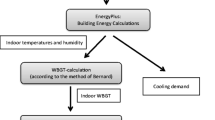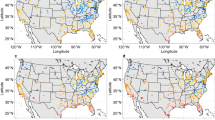Summary
Sensitivity of building-energy consumption to changing urban environments is examined by simulating building energy loads in hypothetical urban settings. A modified version of an algorithm developed by the U.S. Army Construction Engineering Research Laboratory is used to evaluate energy requirements. Energy loads for two buildings of interest are estimated for changing climatic conditions (air temperature) as well as changing environments around the building. An isolated building and a building surrounded by several other buildings are considered.
Results indicate that climate warming may lead to energy savings in a wide range of climates while savings also depend on the nature of the building and its use. In cool climates, climate warming forces net energy-load decreases through reductions of the winter heating loads. For example, a one-degree increase in annual air temperature in Duluth led to a 10 kWh decrease in net energy loads for a small office building. In warm climates, urbanization tends to accelerate energy consumption although shadowing may contribute significantly to decreases in summer cooling loads. In Phoenix, annual mean daily net energy loads decreased by about 10 kWh due to shadowing for the same office building. Even in relatively cool regions, summer cooling-load reductions caused by shadowing are effective.
Similar content being viewed by others
References
Alberta Agriculture, 1983:New House Planning and Idea Book. Andover, Massachusetts: Brick House Publishing Company.
Aida, M., 1982: Urban albedo as a function of the urban structure — a model experiment.Bound. Layer Meteor. 23, 405–413.
Aida, M., Gotoh, K., 1982: Urban albedo as a function of the urban structure — a two-dimensional numerical simulation.Bound-Layer Meteor. 23, 415–424.
Arnfield, A. J., 1976: Numerical modeling of urban surface radiative parameters. Papers in Climatology: the Cam Allen Memorial Volume Discussion Paper No. 7., Department of Geography, McMaster University.
Arnfield, A. J., 1982: An approach to the estimation of the surface radiative properties and radiation budgets of cities.Phys. Geogr. 3, 97–122.
ASHRAE Task Group, 1976: Procedure for determining heating and cooling loads for computerizing energy calculations. Algorithms for building heat transfer subroutines. Atlanta, Georgia: Compiled and published by the ASHRAE Task Group on energy requirements for heating and cooling of buildings. American Society of Heating, Refrigerating and Air-conditioning Engineers, Inc.
ASHRAE, 1980:Manual of acceptable practice for ASHRAE STANDARD 90-75. Atlanta, Georgia: American Society of Heating, Refrigerating, Air-conditioning Engineers, Inc.
ASHRAE, 1981:ASHRAE Handbook Fundamentals. Washington, D.C.: American Society of Heating, Refrigerating, and Air-conditioning Engineers, Inc.
BLAST Support Office, 1986: BLAST 3.0 user's manual. Department of Mechanical and Industrial Engineering, University of Illinois at Urbana-Champaign.
BLAST Support Office, 1988: TARP Load algorithms (excerpt). Department of Mechanical and Industrial Engineering, University of Illinois at Urbana-Champaign.
Energy Information Administration, 1989: Annual Energy Review 1989. Technical report, Department of Energy.
Gray, W. A., Muller, R., 1974:Engineering Calculations in Radiative Heat Transfer. New York: Pergamon Press.
IMSL, 1987: USER'S MANUAL. MATH/LIBRARY. Version 1.0. IMSL, Inc.
Jaluria, Y., Torrance, K. E., 1986:Computational Heat Transfer. New York: Hemisphere.
Landsberg, H. E., 1981:The Urban Climate: International Geophysics Series, Vol. 28. New York: Academic Press.
Matsuura, K., 1991: Local climate change and building energy consumption.Publications in Climatology. 44, 1–80.
Mckey, G. A., Allsopp, T., 1980: The role of climate in affecting energy demand/supply. In: Back, W. et al. (eds.)Interactions of Energy and Climate. Dordrecht, Holland: D. Reidel.
Nunez, M., Oke, T. R., 1976: Long-wave radiation flux divergence and nocturnal cooling of the urban atmosphere. II: Within an urban canyon.Bound.-Layer Meteor. 10, 121–135.
Nunez, M., Oke, T. R., 1977: The energy balance of an urban canyon.J. Appl. Meteor. 16, 11–19.
Oke, T. R., 1973: City size and the urban heat island.Atmos. Environ. 7, 769–779.
Oke, T. R., 1976: The distinction between canopy and boundary-layer urban heat island.Atmosphere 14, 268–277.
Oke, T. R., 1979:Review of Urban Climatology 1973–1976. Technical Note No. 169. Geneva, Switzerland: World Meteorological Organization.
Oke, T. R., 1981: Canyon geometry and the nocturnal urban heat island: comparison of scale model and field observation.J. Climatol. 1, 237–254.
Oke, T. R., 1982: The energetic basis of the urban heat island.Quart. J. Roy. Meteor. Soc. 108, 1–24.
Oke, T. R., 1988: Street design and urban canopy layer climate.Energy and Buildings 11, 103–113.
Sellers, W. D., 1965:Physical Climatology. Chicago: The University of Chicago Press.
Siegel, R., Howell, J. R., 1981:Thermal Radiation Heat Transfer. New York: Hemisphere.
Verseghy, D. L., Munro, D. S., 1989: Sensitivity studies on the calculation of the radiation balance of urban surfaces: I. shortwave radiation.Bound.-Layer Meteor. 46, 309–331.
Author information
Authors and Affiliations
Additional information
With 12 Figures
Rights and permissions
About this article
Cite this article
Matsuura, K. Effects of climate change on building energy consumption in cities. Theor Appl Climatol 51, 105–117 (1995). https://doi.org/10.1007/BF00865545
Received:
Issue Date:
DOI: https://doi.org/10.1007/BF00865545




